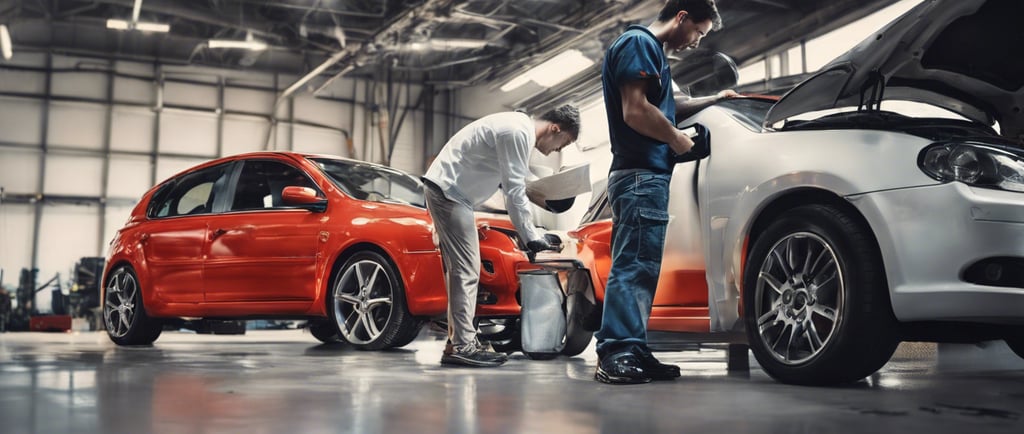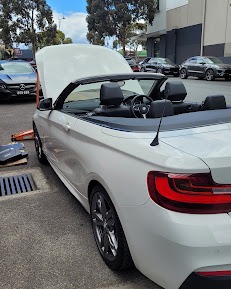Emergency Fuel Delivery Services: Who Can Help When Your Car Runs Empty?
Emergency Fuel Delivery Services: Who Can Help When Your Car Runs Empty?
1/2/20258 min read


Understanding Emergency Fuel Delivery
Emergency fuel delivery services are specialized assistance options designed to provide a timely solution for individuals who find themselves stranded due to an empty fuel tank. These services are often employed in various situations where a vehicle runs out of gas, particularly in remote locations or during late-night travels when other options may not be readily available. The primary function of emergency fuel delivery services is to quickly bring the necessary fuel to the stranded motorist, allowing them to continue their journey without delay.
Typically, individuals may require emergency fuel delivery in scenarios such as when they misjudge their remaining fuel supply during a long drive or when unexpected detours lead them to areas lacking nearby gas stations. Further complicating matters, driving late at night increases the likelihood of exhausting fuel reserves, as fewer service stations may be operational during these hours. In such circumstances, emergency fuel delivery offers a practical solution, ensuring that drivers are not left helpless and vulnerable.
The convenience of emergency fuel delivery services cannot be overstated. They often operate 24/7, allowing drivers to access assistance whenever they find themselves in a predicament. Speed is another paramount benefit, as these services are designed to reach stranded motorists quickly, often within a short timeframe. Moreover, utilizing emergency fuel delivery enhances safety, as it mitigates the risks associated with stranded vehicles, particularly in unsafe or poorly lit areas. This service not only alleviates the immediate concern of refueling but also provides peace of mind for drivers aware of the potential dangers of being stranded. Overall, emergency fuel delivery serves as an essential lifeline for individuals facing the uncertainties of an empty fuel tank.
Top Companies Offering Emergency Fuel Delivery
When it comes to emergency fuel delivery services, several companies in the market stand out for their reliability and efficiency. These providers often cater to both local and national clientele, ensuring that vehicle owners can quickly resolve their fuel-related emergencies. Below is an overview of some noteworthy companies in this sector.
One of the most prominent national chains is AAA (American Automobile Association). Known for its extensive roadside assistance services, AAA also includes emergency fuel delivery as part of its offerings. The company operates throughout the United States and offers a rapid response time, often delivering fuel within 30 minutes. AAA provides gasoline and diesel options, with delivery typically included for its members, while non-members may incur additional fees.
Another leading provider is GasBuddy, primarily known for its gas price comparison app. GasBuddy has expanded its services to include emergency fuel delivery via partnerships with local fuel service stations. While their response times may vary depending on the area, GasBuddy aims to deliver fuel within an hour. Customers benefit from competitive pricing due to GasBuddy's partnerships with local suppliers, and they can request delivery directly through the app.
FairyFuel is a more localized option that specializes in on-demand fuel delivery. Operating in major metropolitan areas, FairyFuel promises delivery within 30 minutes for its customers, providing convenience for those in urgent situations. They offer various fuel types, such as premium and regular gasoline, and their pricing structure is transparent, often showing competitive rates compared to local gas stations.
Lastly, Mobile Fuel Pros focuses on delivering fuel to both consumers and businesses. Predominantly serving urban areas, they ensure a prompt response with an average delivery time of 15 to 45 minutes. Their services include delivery for gasoline, diesel fuel, and even propane. Mobile Fuel Pros prides itself on competitive pricing and ease of access through their user-friendly app.
In summary, these companies exemplify the array of emergency fuel delivery services available, each with unique offerings critical for drivers facing fuel shortages.
How to Request Emergency Fuel Delivery
When your vehicle unexpectedly runs out of fuel, knowing how to request emergency fuel delivery can be crucial. The first step in this process is identifying a reliable fuel delivery service, which can often be found through mobile apps or websites. Popular platforms include roadside assistance programs linked to insurance policies, as well as dedicated service providers specializing in fuel delivery.
To initiate a fuel delivery request, you may follow these simple steps. Start by choosing a service provider and contacting them—this can typically be done via a mobile app, website, or phone call. When reaching out to a service, be prepared to provide essential information. This includes your current location, the make and model of your vehicle, and an indication of the nearest landmark or street address to assist the delivery personnel in finding you quickly.
Additionally, you should inform the service provider of your vehicle's fuel type, whether gasoline or diesel, to ensure they bring the correct fuel. It is also advisable to mention any difficulties accessing your vehicle, such as a locked door or heavy traffic if applicable. Timing is of the essence; therefore, remain attentive and responsive on the call or app to expedite the process.
Some services also allow for setting up your request through a special account, which could save time during emergencies since your details will already be stored. Once your request is placed, you should receive a confirmation along with an estimated arrival time. Staying updated on your provider’s location, when possible, can further help manage your expectations. Overall, being prepared with the necessary information and employing the right platforms can make the experience of requesting emergency fuel delivery smoother and faster.
What to Expect During Fuel Delivery
When an emergency fuel delivery is requested, there are several key steps and precautions that you can expect during the process. Once you place your call to the fuel delivery service, a representative will gather the essential details, including your location and vehicle type. This information is critical as it helps the delivery personnel prepare the right amount and type of fuel for your vehicle, whether it is petrol or diesel.
Upon arrival, the delivery vehicle will typically park at a safe distance from your car to prevent accidents. The driver will first ensure that the area is secure. This may involve conducting a quick assessment of the surroundings and checking for any potential hazards, such as busy traffic or poor visibility. Safety is a top priority during any fuel transfer procedure, so the delivery personnel will wear protective gear and ensure that all safety protocols are followed.
Once it is safe to proceed, the driver will prepare to transfer the fuel. This involves inspecting both the fuel tank and the delivery equipment to ensure compatibility and smooth operation. The fuel is then transferred through a hose connected directly to your vehicle’s fuel tank. Depending on the service, this process can be done manually or with specialized equipment designed for efficiency and safety. During this period, it is important for vehicle owners to remain at a safe distance while also being available to answer any questions the driver may have.
Following the fuel transfer, the driver will conduct a quick inspection to confirm that everything is functioning properly and that there are no leaks. Finally, you may need to start your vehicle to ensure that it runs smoothly after receiving the emergency fuel delivery. By understanding these steps, drivers can ensure the process goes as smoothly and efficiently as possible.
Tips for Avoiding Fuel Emergencies
Running out of fuel can be a stressful experience, but with proper planning and awareness, drivers can avoid such emergencies. The first step in preventing fuel-related issues is to regularly monitor your vehicle's fuel gauge. By keeping an eye on the fuel levels, drivers can easily gauge when it might be necessary to refuel before the tank reaches critically low levels.
Another important aspect to consider is understanding your vehicle's mileage per tank. Each car has its specific brake horsepowers, which dictate how far it can go on a full tank of gas. Familiarizing yourself with this information allows you to make better decisions about when and where to refuel, especially on longer journeys. It's advisable to refuel when the gauge indicates approximately a quarter tank, as this provides a buffer against unexpected delays or detours.
Planning your routes ahead of time can significantly reduce the risk of experiencing a fuel shortage. Utilizing GPS systems or mapping applications, drivers can identify gas stations along the way and incorporate these stops into their travel itinerary. This foresight is particularly valuable for road trips or travel through rural areas, where gas stations may be scarce. Additionally, some mobile applications can track fuel levels and send reminders to refuel, making it easier for drivers to stay proactive.
Finally, keeping an emergency fuel canister in the trunk of your vehicle can serve as a safety net. This backup method provides peace of mind, especially in situations where reaching a gas station might not be immediately feasible. In summary, by actively monitoring fuel levels, understanding vehicle mileage, planning routes accordingly, and leveraging technology, drivers can effectively minimize the risk of encountering fuel crises. These preventive measures foster a safe and reliable driving experience.
Cost Considerations of Emergency Fuel Delivery
Emergency fuel delivery services provide a necessary solution when drivers find themselves with an empty tank and unable to refuel. Understanding the costs associated with these services is essential for making informed decisions. On average, the fees charged for emergency fuel delivery can range from $50 to $150, depending on several factors. Many companies may have a standard fee structure, but it is crucial to inquire about any additional costs that may arise.
A common consideration in pricing is the time of service. After-hours surcharges are often applied if assistance is requested outside regular business hours, typically increasing the overall cost by $20 to $50. Additionally, geographic location significantly impacts the price of emergency fuel delivery. Urban areas may have more competitive pricing due to a higher volume of service providers, whereas rural locations could face higher fees due to travel distance and limited service availability.
Another important aspect of pricing is the type of vehicle needing assistance. Larger vehicles, such as trucks or SUVs, may lead to increased charges due to the additional fuel that may be required for the service or if specialized equipment is needed to perform the delivery. Furthermore, the quantity of fuel delivered can also influence the overall cost; while most services provide a minimum amount, requests for larger quantities may result in increased fees.
Lastly, it is worth considering whether insurance coverage can help offset some of these costs. Certain auto insurance policies may include roadside assistance as part of their coverage, which can alleviate the financial burden associated with emergency fuel delivery services. Exploring the specifics of your policy could reveal ways to mitigate costs while ensuring you are prepared for unforeseen circumstances on the road.
Customer Experiences and Reviews
When evaluating emergency fuel delivery services, customer experiences and ratings provide crucial insights into the performance and reliability of these services. Many individuals who have utilized these services offer feedback that highlights various aspects, including response time, service efficiency, and overall satisfaction.
One common thread among customer reviews is the emphasis on speed. Numerous users report positive experiences with services that were able to deliver fuel promptly, often within 30 minutes. This timeliness can be critical for drivers who find themselves in a pinch and are in need of immediate assistance. Customers frequently express appreciation for companies that provide real-time updates on the arrival of their delivery, allowing for better planning and reduced anxiety during a stressful situation.
In addition to speed, reliability of the service is a recurrent theme in the feedback. Many customers highlight their disappointment when a service fails to meet its commitments, such as not arriving as scheduled or bringing incorrect fuel types. Conversely, those who had positive experiences noted that their chosen service was credible and trustworthy, reinforcing the importance of reliability in the selection process. Customer reviews also reflected on the professionalism of delivery personnel, noting that a friendly and knowledgeable driver can significantly improve the overall experience.
Furthermore, customer service plays a pivotal role in shaping perceptions of emergency fuel delivery services. Positive interactions with support staff, especially during the initial inquiry or when seeking assistance, tend to leave a lasting impact. Those who experienced efficient and courteous communication reported high levels of satisfaction, making them more likely to recommend the service to others.
Ultimately, analyzing customer experiences and reviews helps prospective users make well-informed decisions about which emergency fuel delivery service to choose, ensuring that they select a service that aligns with their needs for reliability, speed, and quality customer service.


